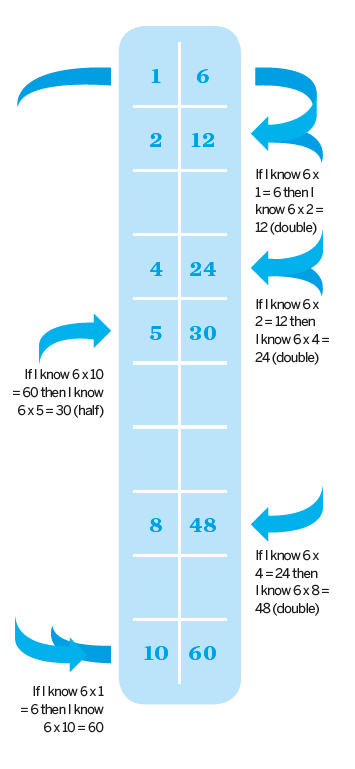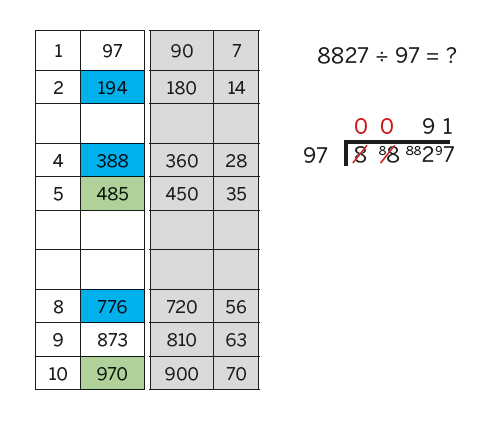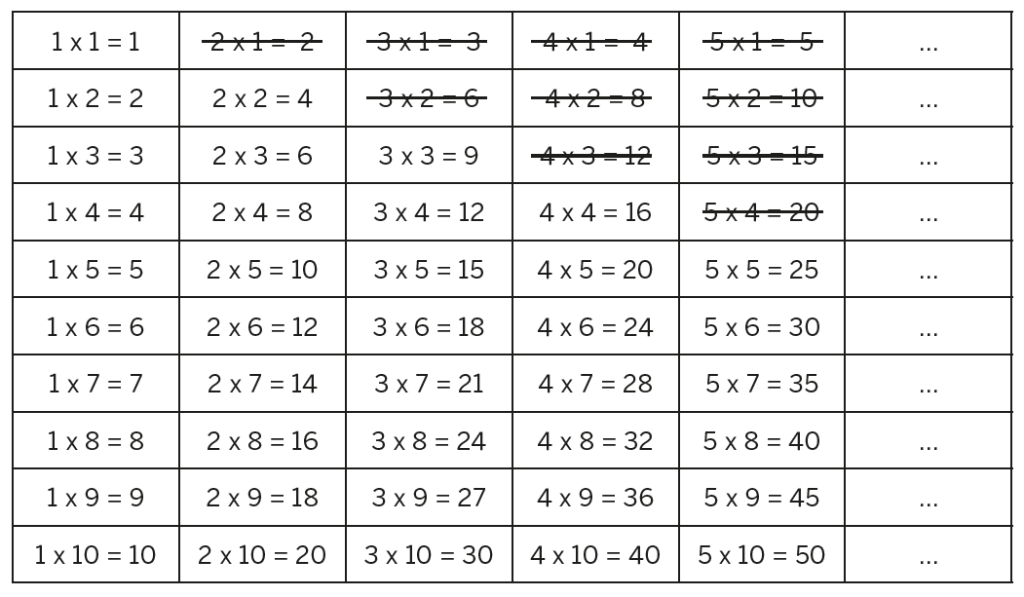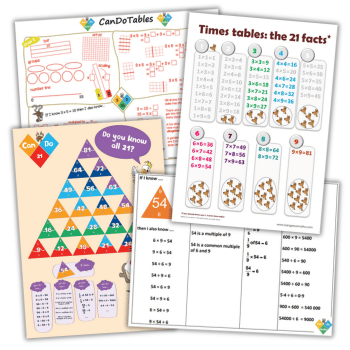This times tables KS2 resource features a range of PDFs and a spreadsheet that will help children ace the Year 4 times tables test. Resources include:
- Times tables posters, including 21 facts
- ‘Draw it, dissect it, derive it, deepen it’ worksheet
- ‘If I know’ FactorFactorProduct mat
- Interactive target boards
How to prepare for the Year 4 times tables test

Now is the time to review your learning strategies, says maths lead Steve Lomax…
In the DfE multiplication tables check (MTC) framework it states that the purpose of the Year 4 times tables test is to “determine whether pupils can recall their times tables fluently, which is essential for future success in mathematics”.
While most wouldn’t disagree that pupils ‘knowing’ the times tables is important, assessing the rapid recall of only multiplication facts in an online test for example, 6 x 9 = _, will not achieve this ambition.
Many facts
A counterargument is that being able to know and apply multiplicative facts, or ‘factor-factor-product’ relationships, such as 6-9-54, is essential to future success in mathematics.
If a Y4 pupil knows 6-9-54 then they will know many, many facts – multiplication, division, place value, fractions – not just one multiplication fact!
You can adapt the CanDoMaths ‘If I know … then I also know’ FactorFactorProduct mat (included in this download) for other relationships such as 7/8/56.
The national curriculum states that by the end of Y4, pupils should have memorised their times table grid up to and including the 12 multiplication table. They should “show precision and fluency in their work.”
Mastering times tables
The DfE MTC assessment framework states that “it will help schools to identify pupils who have not yet mastered their times tables, so that additional support can be provided”.
Mastered the times tables – really? A pupil that knows the multiplicative relationships, and is able to use them to state related facts, has a ‘mastery’ – that is, a secure and deep understanding – and fluency – that is, accuracy, efficiency and flexibility – of the times tables.
I don’t think the same can be said for a pupil who can recall one isolated multiplication fact in the Year 4 times tables test, however quickly.

Teach Up, Keep Up
Many schools are now thinking carefully about the amount, and efficient use, of curriculum time for mathematics.
They use a ‘TeachUpKeepUp’ structure to support both intelligent and deliberate practice. This is a shorter mathematics ‘Teach Up’ lesson (up to 45 minutes) to secure and deepen understanding of one small key learning point for all children.
There’s then an additional shorter ‘Keep Up’ Meeting (15 to 30 mins) to deliberately practise previous learning, arithmetical skills and/or immediate intervention.
Deliberate and purposeful practise of this skill is a perfect activity for a ‘Maths On Track’ meeting using a grid with different starting numbers, such as the one from Kangaroo Maths that randomly generates the starting numbers (included in this download).
This also supports future work on multiplication and division in Upper KS2, for example written methods for division, when finding the multiples of the divisor is often the barrier to success:

21 times table facts
If I know 3 x 7 = 21 then, by the commutative nature of multiplication, I also know 7 x 3 = 21.
Pupils creating a poster like this is a very empowering activity:

- Write out all the 1x to 10x (or 12x) tables.
- Cross out the related commutative fact, for example 2 x 1, 3 x 1, 3 x 2, etc.
- 100 facts are suddenly reduced to 55 facts.
- Take it one step further. Cross out any facts related to 2x, 5x and 10x (end of KS1 age-related expectation) and 1x facts.
- Only 21 facts are left!
All of a sudden, all children are now empowered as they can remember 21 facts! You can also download free versions (included in this download).
Steve Lomax is the strategic mathematics lead of the Balcarras Teaching School, a nationally accredited NCETM professional development lead and teaching for mastery lead. He is the co-founder of Kangaroomaths and CanDoMaths. Follow him on Twitter at @MaxTheMaths.
5 tips to reduce Year 4 times tables test stress

Here are five steps to help reduce the stress of the Year 4 times tables test, says Mike Askew…
1) Emphasise multiplication is commutative as soon and as much as possible
Knowing that for every multiplication fact you know you also get one free reduces the load. Know 4 x 6 is 24, then 6 x 4 is 24.
The array is the best image for helping children, right from the start, get a sense of how and why multiplication is commutative.
An image of a four-by-six array is transformed into a six-by-four array simply by rotating it through 90 degrees.
While it is popular to show multiplication as jumps on a number line, it is not quite so obvious why four jumps of six should land on the same final number as six jumps of four.
2) Focus on 2 times, 10 times, 5 times and 4 times
When thinking about how to teach times tables, being confident in the ‘low hanging fruits’ of 2s, 10s, 5s and 4s facts provides a strong foundation for the remaining facts.
Working on doubling is central to two times facts, and doubling twice gives you four times facts. Ten is easy, and halving helps ground the five times facts.
3) Put the smaller number first
Pupils in Japan are explicitly taught to reverse multiplication calculations if the smaller number is second. Seven times four? Do not do that; do four times seven.
This has a double pay-off. Firstly, you are often going to end up with 2, 4, 5 or 3 as the first number – and they are easy (see tip 2).
Second, if you need to do some skip counting to get the answer, then that is going to be quicker with the smaller number first.
Seven times two means counting “two, four, six, eight, ten, twelve, fourteen”. But two times seven, hey, it is just seven, fourteen.
4) Teach the Chinese tables
The astute reader may have noticed that I have not used the words ‘times tables’ so far. That is because I am not convinced that chanting a times table grid is the best way of getting to know your multiplication facts.
I would much rather a child knew that, say, four times nine is 18 (double nine), 36 (double again), than have to chant through the four times table.
But if you think tables help, the Chinese versions are rather more sensible that ours. In China, the two times table is:
1 x 2 = 2
2 x 2 = 4
And that’s it! Three times and four times tables:
1 x 3 = 3
2 x 3 = 6
3 x 3 = 9
—
1 x 4 = 4
2 x 4 = 8
3 x 4 = 12
4 x 4 = 16
Each table only goes up as far as the square of the table number, so the seven times table is:
1 x 7 = 7
2 x 7 = 14
3 x 7 = 21
4 x 7 = 28
5 x 7 = 35
6 x 7 = 42
7 x 7 = 49
So, you might ask, if the two times tables ends at 2 x 2, when do the children learn what 9 x 2 is?
Well, they do not directly, but they work a lot on multiplication being commutative (tip 1) and putting the smaller number first (tip 3). So given 9 x 2 they know that is equivalent to 2 x 9 and, hey, that is 18.
Our tables put an extra burden on children by asking them to memorise each multiplication fact twice, once as 9 x 2 in the two times table and again as 2 x 9 in the nine times table!
4) Practice little and often
There is some truth to the adage of ‘use it or lose it’. We cannot assume that the child who knew some multiplication facts last year is still confident with them this year.
Overlearning is important – repeatedly going back, just for a few minutes, to recap on the multiplication facts that children know and building their confidence.
Mike Askew is adjunct professor of education at Monash University, Melbourne. A former primary teacher, he now researches, speaks and writes on teaching and learning mathematics. Find him at mikeaskew.net and follow him on Twitter at @mikeaskew26.
More times table resources
- Simple 12×12 times table grid
- Times tables worksheets bumper pack
- More times tables activities














